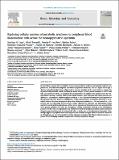Por favor, use este identificador para citar o enlazar a este item:
http://hdl.handle.net/10261/265749COMPARTIR / EXPORTAR:
 SHARE SHARE
 CORE
BASE CORE
BASE
|
|
| Visualizar otros formatos: MARC | Dublin Core | RDF | ORE | MODS | METS | DIDL | DATACITE | |

| Título: | Exploring cellular markers of metabolic syndrome in peripheral blood mononuclear cells across the neuropsychiatric spectrum |
Autor: | Lago, Santiago G.; Tomasik, Jakub; van Rees, Geertje F.; Rubey, Marina; González-Vioque, Emiliano; Ramsey, Jordan M.; Haenisch, Frieder; Broek, Jantine A.; Vázquez-Bourgon, Javier; Papiol, Sergi; Suárez-Pinilla, Paula; Ruland, Tillmann; Auyeung, Bonnie; Mikova, Olya; Kabacs, Nikolett; Arolt, Volker; Baron-Cohen, Simon; Crespo-Facorro, Benedicto CSIC ORCID CVN; Bahna, Sabine | Palabras clave: | Neuropsychiatric conditions Metabolic syndrome Peripheral blood mononuclear cell Cell surface marker Insulin sensitivity Polygenic risk score Homeostasis model assessment Antipsychotic treatment Response prediction Weight gain Flow cytometry |
Fecha de publicación: | ene-2021 | Editor: | Elsevier | Citación: | Brain, Behavior, and Immunity 91: 673-682 (2021) | Resumen: | Recent evidence suggests that comorbidities between neuropsychiatric conditions and metabolic syndrome may precede and even exacerbate long-term side-effects of psychiatric medication, such as a higher risk of type 2 diabetes and cardiovascular disease, which result in increased mortality. In the present study we compare the expression of key metabolic proteins, including the insulin receptor (CD220), glucose transporter 1 (GLUT1) and fatty acid translocase (CD36), on peripheral blood mononuclear cell subtypes from patients across the neuropsychiatric spectrum, including schizophrenia, bipolar disorder, major depression and autism spectrum conditions (n = 25/condition), relative to typical controls (n = 100). This revealed alterations in the expression of these proteins that were specific to schizophrenia. Further characterization of metabolic alterations in an extended cohort of first-onset antipsychotic drug-naïve schizophrenia patients (n = 58) and controls (n = 63) revealed that the relationship between insulin receptor expression in monocytes and physiological insulin sensitivity was disrupted in schizophrenia and that altered expression of the insulin receptor was associated with whole genome polygenic risk scores for schizophrenia. Finally, longitudinal follow-up of the schizophrenia patients over the course of antipsychotic drug treatment revealed that peripheral metabolic markers predicted changes in psychopathology and the principal side effect of weight gain at clinically relevant time points. These findings suggest that peripheral blood cells can provide an accessible surrogate model for metabolic alterations in schizophrenia and have the potential to stratify subgroups of patients with different clinical outcomes or a greater risk of developing metabolic complications following antipsychotic therapy. | Versión del editor: | http://dx.doi.org/10.1016/j.bbi.2020.07.043 | URI: | http://hdl.handle.net/10261/265749 | DOI: | 10.1016/j.bbi.2020.07.043 | Identificadores: | doi: 10.1016/j.bbi.2020.07.043 issn: 0889-1591 |
| Aparece en las colecciones: | (IBIS) Artículos |
Ficheros en este ítem:
| Fichero | Descripción | Tamaño | Formato | |
|---|---|---|---|---|
| neuropsychiatric_spectrum.pdf | 850,28 kB | Adobe PDF |  Visualizar/Abrir |
CORE Recommender
SCOPUSTM
Citations
15
checked on 10-abr-2024
WEB OF SCIENCETM
Citations
13
checked on 29-feb-2024
Page view(s)
29
checked on 18-abr-2024
Download(s)
47
checked on 18-abr-2024
Google ScholarTM
Check
Altmetric
Altmetric
Este item está licenciado bajo una Licencia Creative Commons

